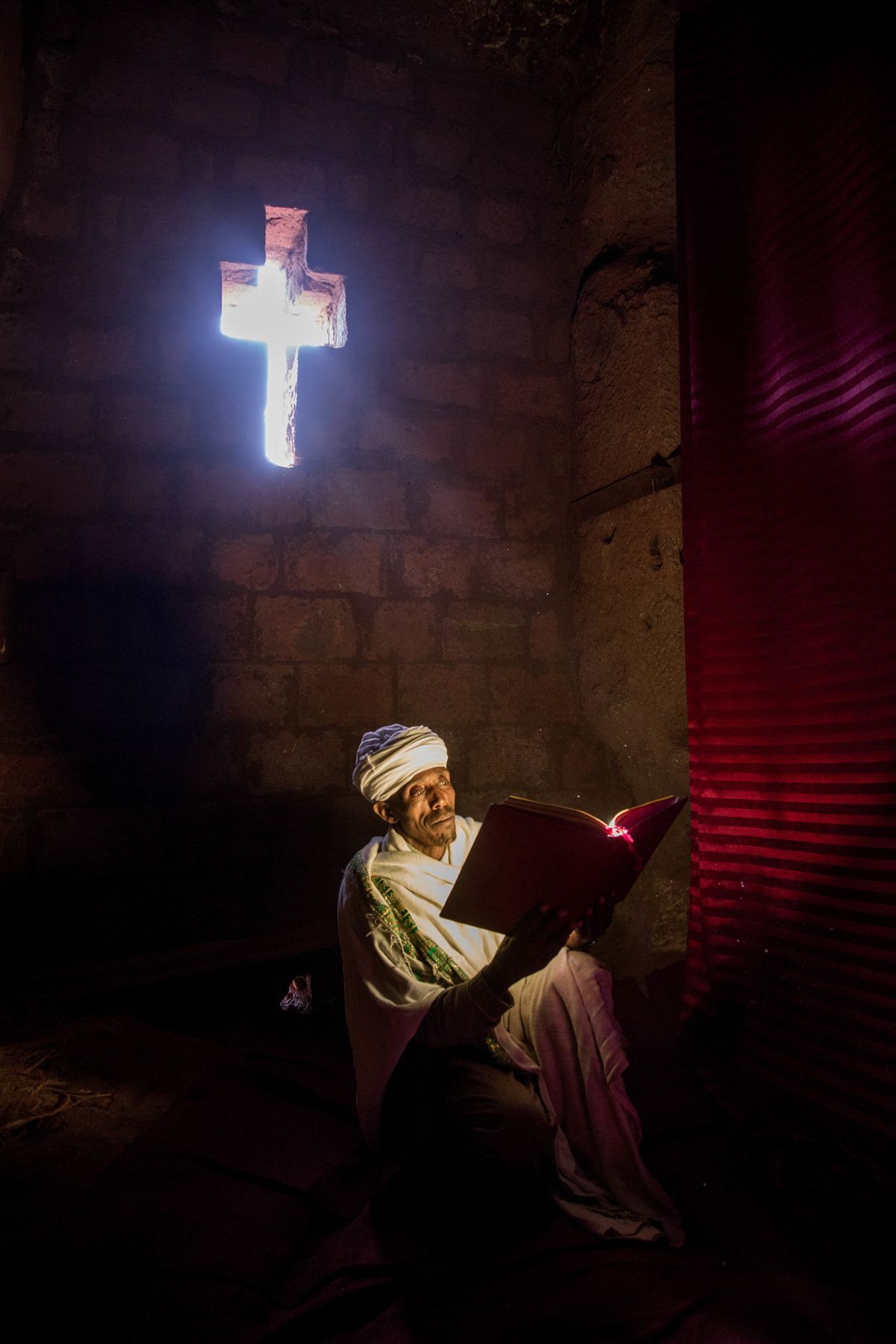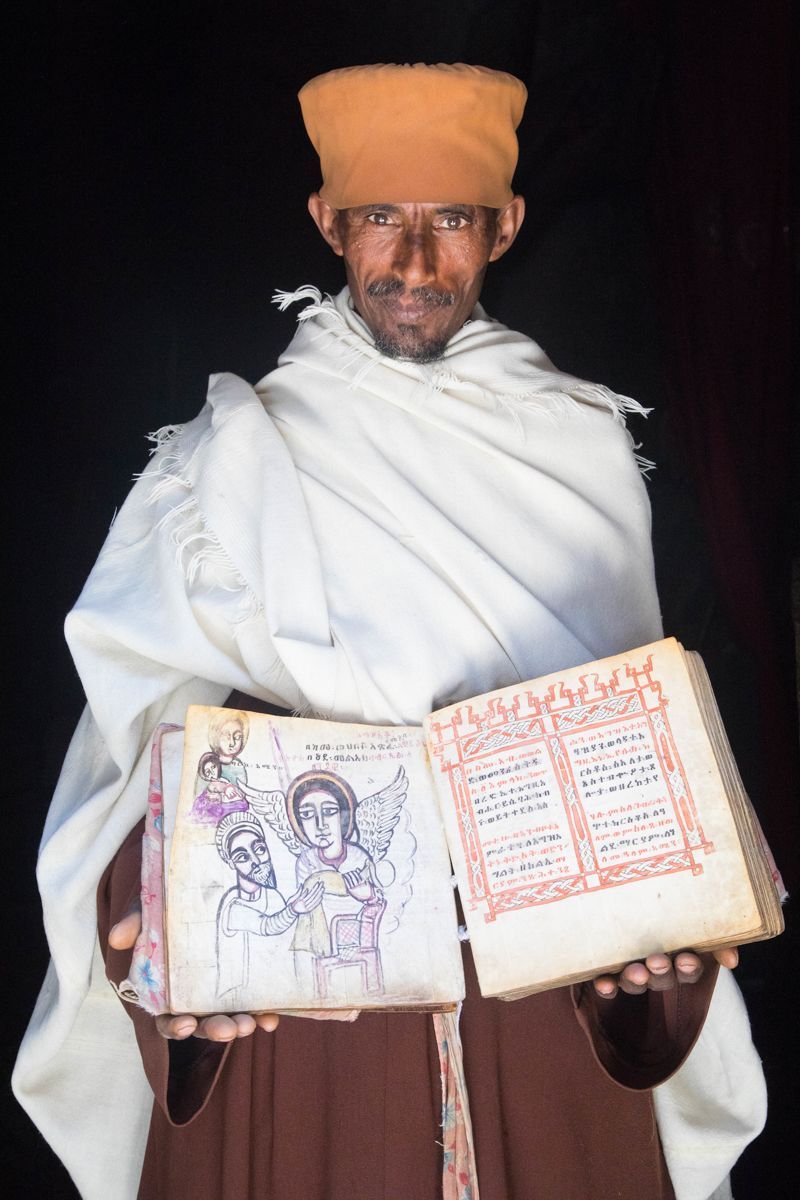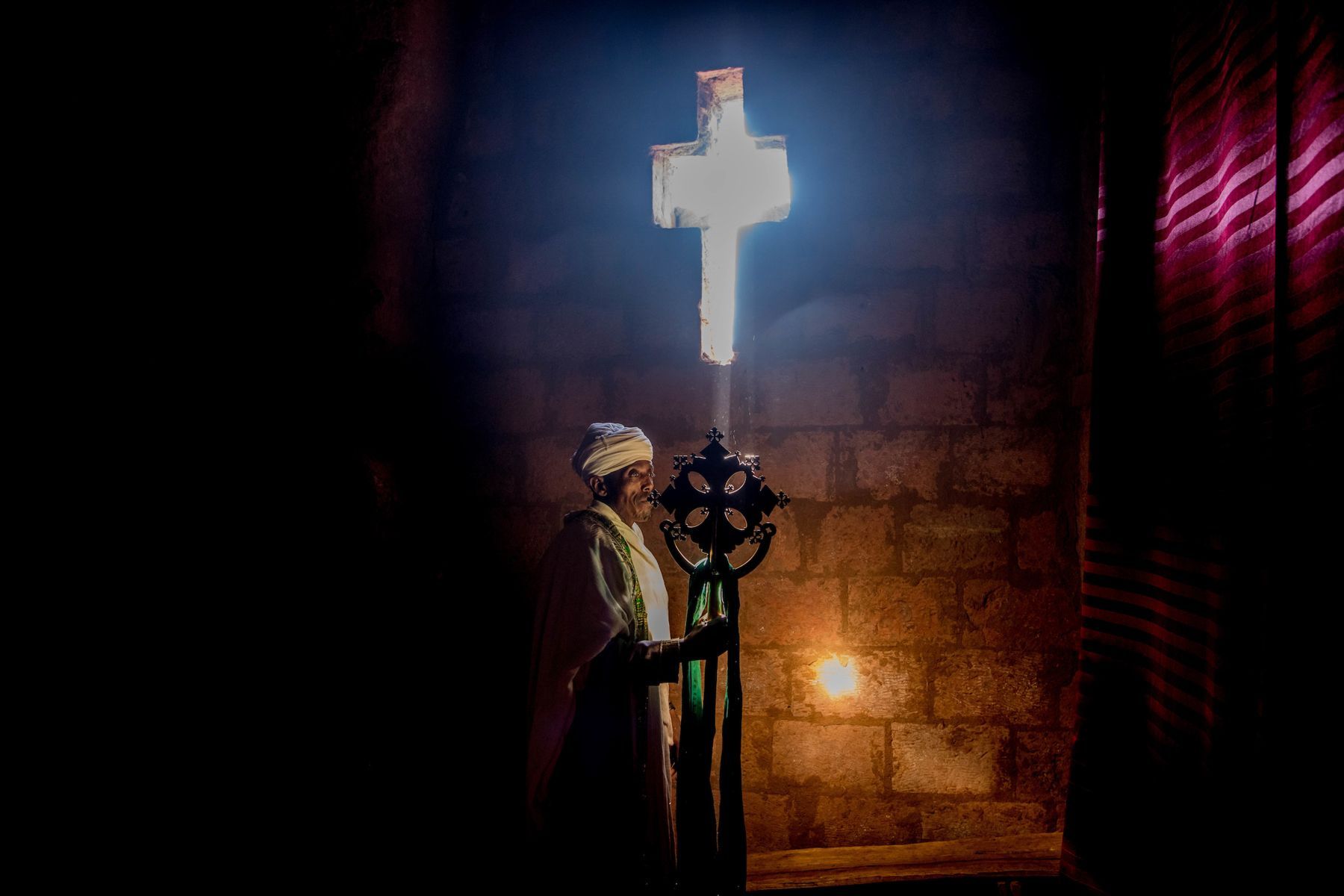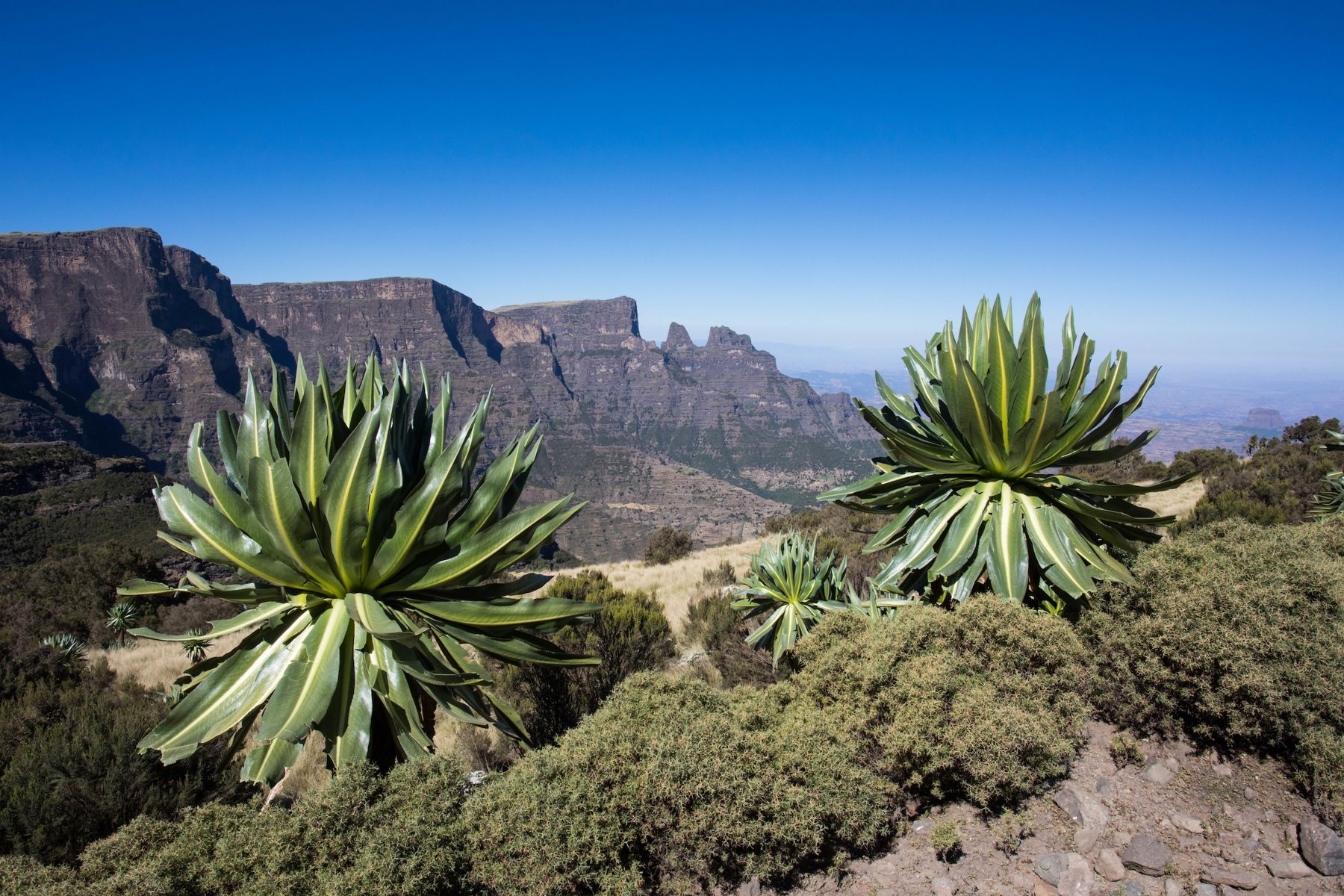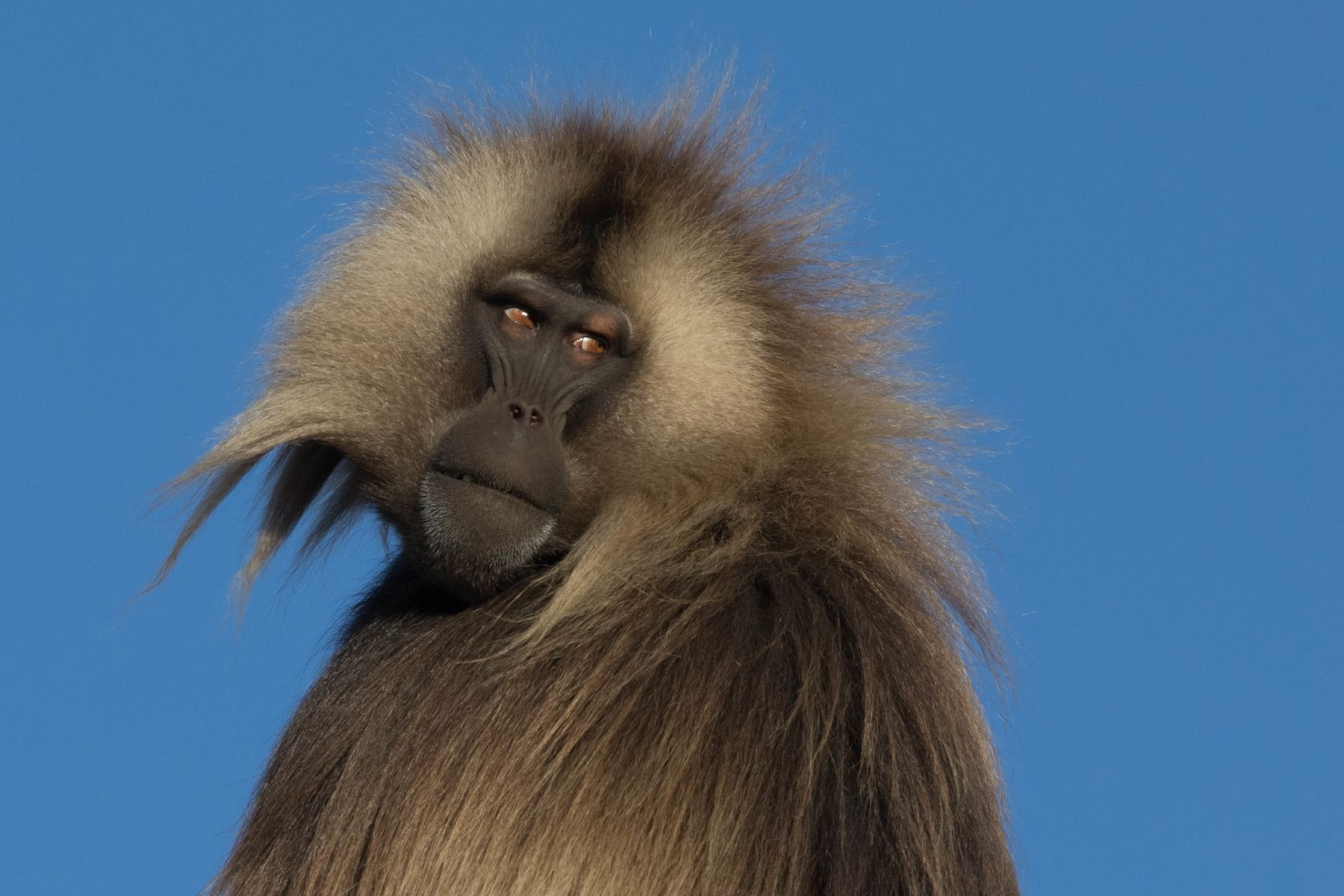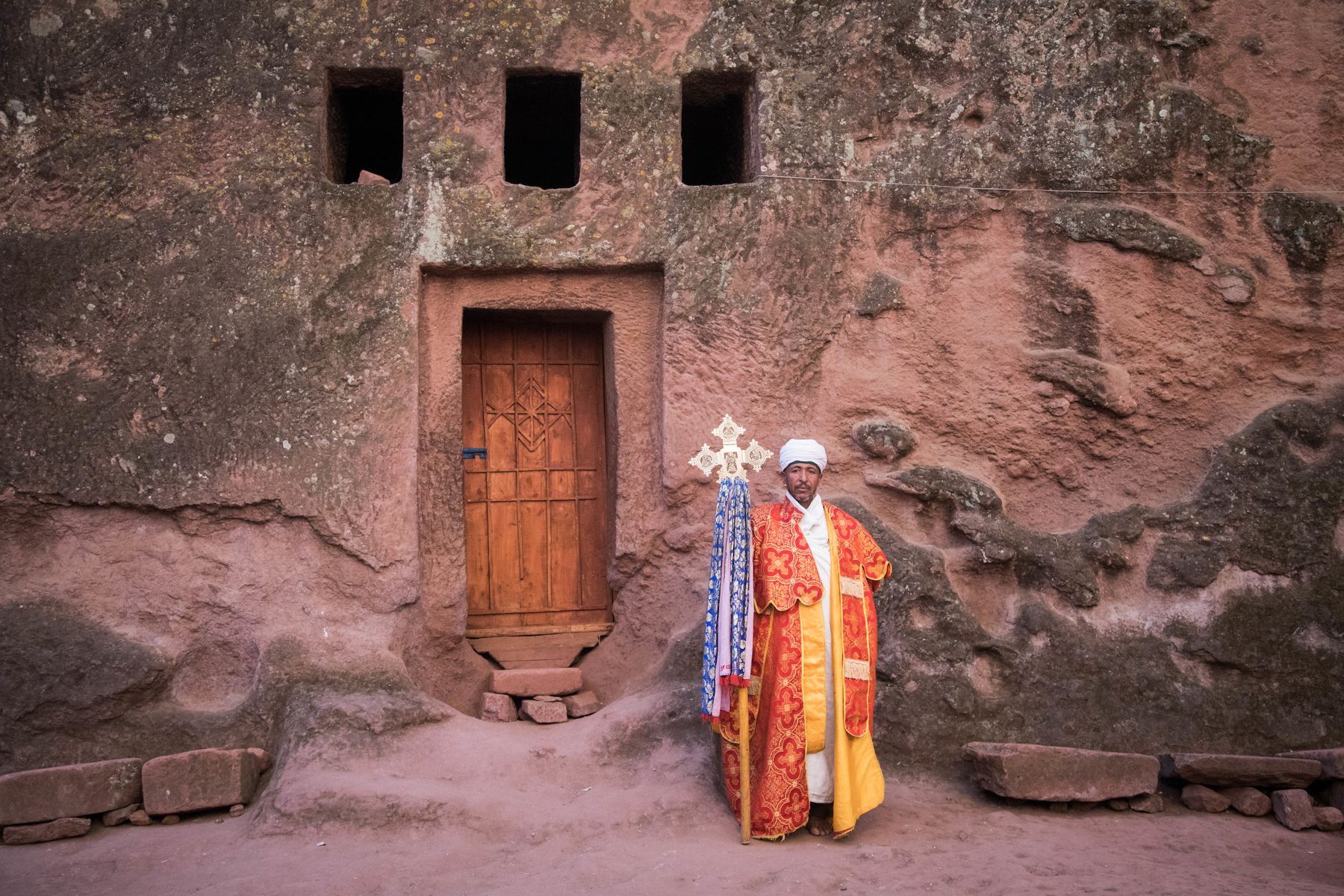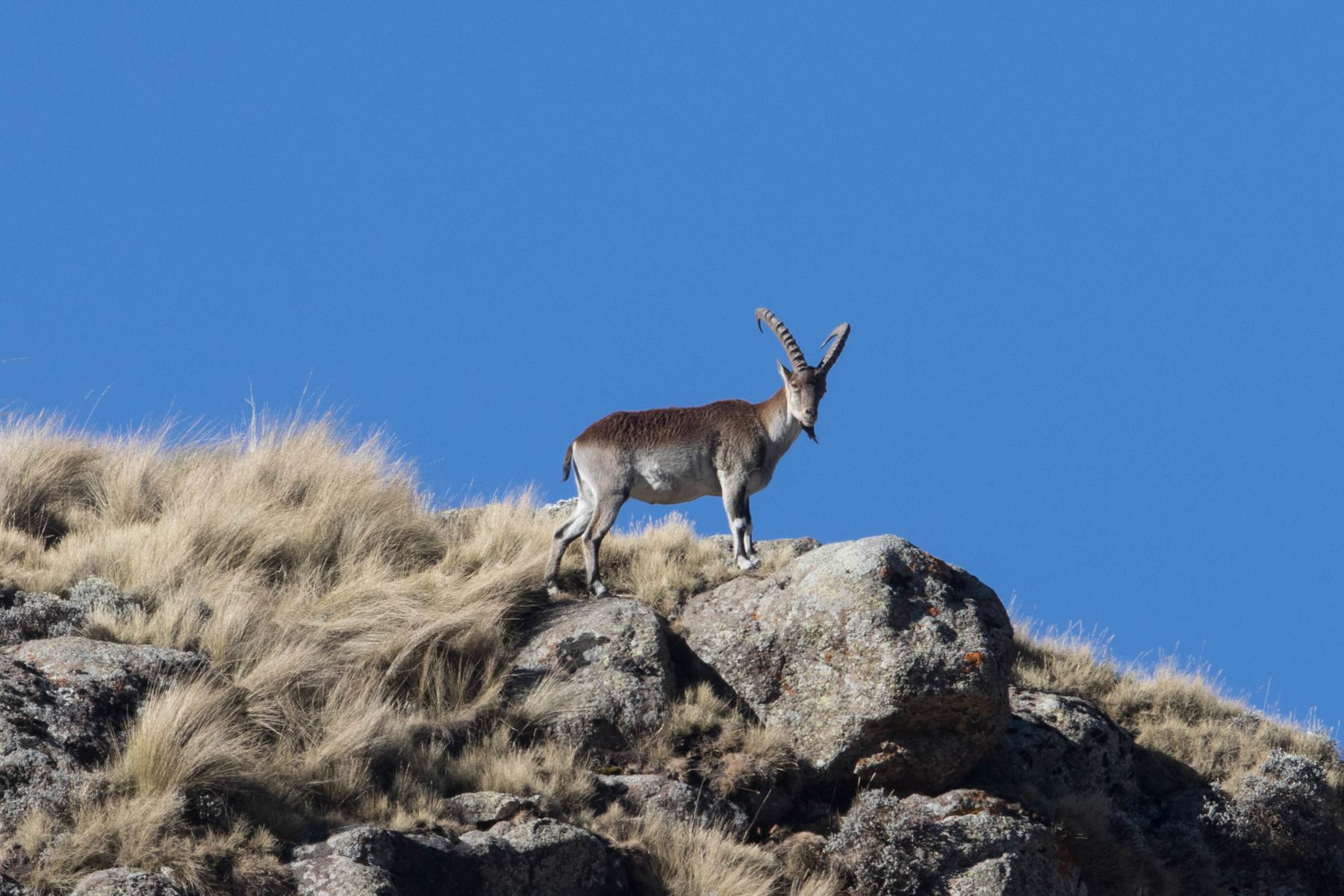Africa
ETHIOPIA: HIGHLANDS & HOLY SITES – A journey to the stunning Simien Mountains and the Holy Churches of Lalibela




























The elaborate ceiling paintings of the Debre Birhan Selassie church in Gondar, Ethiopia (Image by Inger Vandyke)

Endemic Walia Ibex locking horns in the Simien Mountains. Walias surely epitomize the plight of Ethiopia's endangered wildlife (Image by Inger Vandyke)

A Lalibela Priest holding a candle (Image by Inger Vandyke)

A Lalibela priest reads his bible by the light shining through a crucifix shaped 'window' in a rock church (Image by Inger Vandyke)

Aba Mezgebe's feet, Asheten Maryam, near Lalibela (Image by Inger Vandyke)

A pair of huge Thick-billed Ravens in the Simiens, a species endemic to the region (Image by Inger Vandyke)

Simien or Ethiopian Wolf in the Simien Mountains (Image by Inger Vandyke)

Aba Mezgebe's smile (Image by Inger Vandyke)

Lichens cover the outside wall of the St George church in Lalibela, Ethiopia (Image by Inger Vandyke)

Aba Mezgebe, the father of the church at Asheten Maryam near Lalibela, reveals one of his church's ancient bibles (Image by Inger Vandyke)

The church of St George at sunset (Image by Inger Vandyke)

An ancient prayer book at Asheten Maryam (Image by Inger Vandyke)

A priest holding his crucifix at Lalibela in Ethiopia (Image by Inger Vandyke)

A baby Gelada Baboon in the Simien Mountains of Ethiopia (Image by Inger Vandyke)

Portrait of a Simien or Ethiopian Wolf, Ethiopia's most iconic wildlife species (Image by Inger Vandyke)

The pathway up to Asheten Maryam, near Lalibela in Ethiopia (Image by Inger Vandyke)

Lalibela pilgrim (Image by Inger Vandyke)

Wattled Ibis in the mountains of Ethiopia (Image by Inger Vandyke)

The fortress palaces of Gondar, Ethiopia (Image by Inger Vandyke)

A Gelada Baboon gives a mild 'lip-flip' threat display in the Simien Mountains of Ethiopia (Image by Inger Vandyke)

It is not just the wildlife that is unusual in Simien. Giant Lobelias near Chenek (Image by Inger Vandyke)

Gelada Baboon males are magnificent creatures and you can, with care, approach them very closely in the Simien Mountains of Ethiopia (Image by Inger Vandyke)

Prayer sashes at Lalibela (Image by Inger Vandyke)

The rock-hewn churches of Lalibela make for incredible photography (Image by Inger Vandyke)

The priests of Lalibela (Image by Inger Vandyke)

A Walia Ibex peers down from a ridge (Image by Inger Vandyke)
ETHIOPIA PHOTOGRAPHY TOURS WITH WILD IMAGES
There are few other places in Africa where one can enjoy great wildlife and landscape photography and combine it with extraordinary cultural photography experiences. Ethiopia’s northern highlands, the veritable ‘Roof of Africa’ have all of this and more: the awesome landscapes and wildlife of the Simien Mountains, the palaces of Gondar, home of many of Ethiopia’s kings and emperors, and the world-heritage rock churches of ancient Lalibela. Our special Ethiopia photography tours combine all of these wonders. See them for yourself!
Ethiopia’s highlands embrace the central part of the country like a necklace. The incredible Simien Mountains are home to some of Africa’s rarest wildlife, including the Walia Ibex, Simien (or Ethiopian) Wolf and the gentle, vegetarian Gelada Baboon. It is a high altitude wonderland filled with incredible wildlife, soaring cliffs, tussock grasses and stands of iconic Mountain Lobelias. While we explore the dramatic scenery of the Simien Mountains during our Ethiopia photography tours, we will also be looking for a variety of birds of prey, the iconic Thick-billed Raven, the lovely Spot-breasted Plover and the strange-looking Wattled Ibis, a high altitude ibis that is endemic to Ethiopia.
The wildlife highlight of the Simien is undoubtedly the encounters we are going to have with the local Gelada Baboons. These gentle apes are vegetarian and they are usually quite accustomed to visiting wildlife photographers. When we find a troupe, we will simply sit or slowly walk with them as they move across a mountain meadow to graze on grasses and shrubs, while baby baboons play near our feet. As the sun goes lower in the sky we will search for them on the cliff edges as they return to their cliff nests to sleep after a day of grazing on the Simien plateau.
After our adventures in the Simien we will drive to the lively town of Gondar, which served as the former capital of the Ethiopian empire. The city holds the remains of the Fasil Ghebbi, or Royal Enclosure, a walled stone fortress with numerous palace-like buildings connected by grassy paths. Founded by Emperor Fasilides, the Fasilides ‘castle’ is the core building in this palace complex and it is accessed by an ancient stone staircase which leads you to a number of very grand rooms that open on to a balcony where the emperor used to address the Ethiopian people.
The rock-hewn churches of Lalibela are some of the holiest sites in all of Africa. Lying on a hill that is partly surrounded by the town of the same name, the group of churches at Lalibela are presided over by a number of priests who host numerous pilgrims and visitors to these churches each year. Exploring the labyrinth of churches hand carved rock tunnels at Lalibela is an absolute photography highlight of any trip to Ethiopia.
We will visit each of the eleven churches in the complex and conclude one of our days in the famous Biete Giyorgis, or the Church of St George, to watch the sunset give the church a golden hue.
A highlight of our journey to Lalibela will include a relatively easy trek to the hill behind the town to visit the spectacular monastery of Asheten Maryam. The views from Asheten Maryam are so incredibly beautiful. There is quite literally a 270-degree view of the countryside surrounding Lalibela from up there. While the monastery itself is tiny, it is home to some fascinating biblical scriptures including ornamental bibles, scrolls and books.
Listed by UNESCO as a World Heritage site in 1978, Lalibela is a beautiful destination for photography and the ideal place to end our photography tour through the highlands of Ethiopia.
Accommodation and Road Transport
Accommodation during our Ethiopia photography tour will be in good quality lodges and hotels. Transport will be by 4×4 vehicles and minibus (passenger van). Roads are mixed in quality (quite rough in Simien).
Walking
Most of the walks during our Ethiopia photography tours are relatively easy and short, with the exception of the hike to Asheten Maryam which is easy, yet it takes about an hour in each direction, depending on stops for photography.
Climate
The highlands of Ethiopia enjoy pleasant daytime temperatures of around 20 degrees Celsius (roughly 70 Fahrenheit), but at night the temperatures can drop much lower, especially in the Simien (where ground frost is possible).
Photographic Equipment
For wildlife photography in the Simien Mountains you may find a short focal length zoom like a 24-105mm is great for close-up Geladas, but in general a prime lens with a focal length between 400-500mm will be needed, with or without converters. (If your budget does not run to prime lenses, a high quality 100-400mm or similar zoom can be a great alternative.) For landscape and night photography we suggest you bring a wide angle lens from 10mm upwards.
Alternatively, you can get wonderful results during our Ethiopia photography tours with a high quality digital bridge camera with an 18-20x or higher optical zoom and a wide-angle setting equivalent to 24-28mm.
For the priests of Lalibela you may wish to have either a wide angle lens, point and shoot camera, a standard zoom (such as 24-105mm) or even iphones and ipads!
If you have questions about what equipment you ought to bring, please contact us.
This Ethiopia photography tour can be taken together with:
Ethiopia: Danakil Depression Expedition
Photographic Highlights
- Communing with one of Africa’s most charismatic apes, the Gelada Baboon
- The incredible wild landscapes of Chenek in the stunning Simien Mountains
- Searching for the rare Ethiopian Wolves, Walia Ibex, Mennelik’s Bushbuck and Ethiopian Klipspringer plus encounters with Thick-billed Ravens and birds of prey in the most beautiful region of Ethiopia’s highlands
- Explore the ancient fortress of Gonder
- The famous rock hewn churches of Lalibela, one of Africa’s holiest sites
- A trek to the beautiful, remote church of Asheten Maryam, high on the hill above Lalibela
OUTLINE ITINERARY
To see a larger map, click on the square-like ‘enlarge’ icon in the upper right of the map box.
To see (or hide) the ‘map legend’, click on the icon with an arrow in the upper left of the map box.
To change to a satellite view, which is great for seeing the physical terrain (and for seeing really fine details by repetitive use of the + button), click on the square ‘map view’ icon in the lower left corner of the ‘map legend’.
PRICE INFORMATION
Wild Images Inclusions: Our prices include surface transportation, accommodations, meals and entrance fees.
Our tour prices also include all tipping, including tips for local guides, drivers and local people who are willing to be photographed. The value of these inclusions on this Wild Images tour amounts to approximately $300.
Please note that the internal flights in Ethiopia (Addis Ababa-Gondar, Gondar-Lalibela and Lalibela-Addis Ababa) are not included. These flights are inexpensive if included with your international tickets, provided you are flying into Addis Ababa with Ethiopian Airlines. If you prefer to book your own international flights, we will provide details of exactly which flights you need to book when we send out the tour start and end notification. We can provide the internal flight ticket on request for anyone flying into the country with another carrier, should you find this preferable.
Deposit: 20% of the total tour price. Our office will let you know what deposit amount is due, in order to confirm your booking, following receipt of your online booking form.
TO BOOK THIS TOUR: Click here (you will need the tour dates)
2018: £2290, $3000, €2540 Addis Ababa/Addis Ababa.
Single Room Supplement: £280, $367, €311.
This tour is priced in US Dollars. Amounts shown in other currencies are indicative.
Air Travel To & From The Tour: Our in-house IATA ticket agency will be pleased to arrange your air travel on request, or you may arrange this yourself if you prefer.
ETHIOPIA: HIGHLANDS & HOLY SITES PHOTOGRAPHY TOUR: DETAILED ITINERARY
Day 1
We start our Ethiopia photography tour at Addis Ababa airport with an early morning flight to Gondar. On arrival at Gondar Airport we leave directly for the World Heritage site of Simien Mountains National Park. The drive between Gondar and Debark is very scenic, particularly at Kosoye some 32km north of Gondar, where Queen Elizabeth II of England camped in 1965 while driving between Gondar and Axum.
At Debark we will collect a park scout and permits at the park headquarters and then continue our drive to Simien Lodge, where we stay three nights. This afternoon, after lunch at our dramatically-situated lodge (which claims to be the highest lodge in Africa, and they are surely right!) we will start our photographic exploration of the extraordinary Simien Mountains.
Overnight: Simien Lodge
Days 2-3
Created by massive erosion, the Simien Mountains is one of the most spectacular landscapes in the world: jagged mountain peaks with many summits over 4,000m (roughly 13,000ft), deep valleys and 1,500m sheer precipices. The park is home to the highest peak in the country, Ras Dashen, which is 4543 metres (14,906ft) above sea level. The Simien Mountains is also the refuge of the extremely rare Ethiopian (or Simien) Wolf, the extraordinary Gelada Baboon and the endangered Walia Ibex, a wild goat unique to Ethiopia. It is also home to endemic birds such as the Thick billed Raven and Wattled Ibis. In addition to its wonderful scenery and wildlife, the park is also famous for its Afromontane forest, Hypericum woodland, Afromontane grassland and Afro-alpine moorland dominated by Giant Lobelias, Red Hot Pokers, tree heaths, giant St. John’s Wort and African Roses. As you can see, no northern Ethiopia photography tour can afford to miss out the extraordinary Simien!
We will explore the scenic Simien escarpment in order to find the endemic Gelada Baboons. Nicknamed ‘bleeding heart baboon’ and ‘lion-monkey’ for reasons that will soon be obvious to all, Gelada Baboons are peculiar to Ethiopia and Eritrea, still being numerous in the Simien Mountains. Geladas are mainly vegetarian, living on herbs, grasses and roots, but they also eat insects and locusts. Geladas live along the rim and steep slopes of the escarpment, which are their refuge when danger threatens.
The greatest wildlife photography spectacle and experience of the Simien is undoubtedly being amongst its wonderful Gelada Baboons. Unlike other parts of Ethiopia, where the Geladas are often chased away by farmers and habitat is limited, here the herds run into the hundreds. Indeed it is quite possible to come across 300-500 together!
What is more, unlike the rather timid baboons elsewhere in the country, these Geladas are largely unconcerned by humans, so will often allow a very close approach. If you move slowly, and don’t make too much eye-contact (which the Geladas consider aggressive) it is easily possible to get right in amongst the horde and sit or lie amongst them as they go about their business. This is wildlife photography of a unique quality! Seeing and photographing the big males with their extraordinary ‘hairstyle’ and pink-red chest-blaze at close range is quite marvellous. Most of the time they tear off the short herbage and munch away, or groom each other’s fur, but every now and again there is a fight between males, mating or some very amusing playing among the many youngsters. Mothers walk past with babies on their backs and indeed the entire panoply of Gelada life goes on all around you. We can honestly say that the Simien Gelada Baboon wildlife experience is unforgettable and right up there with visiting the much better-known Gorillas of Uganda and Rwanda.
On one day, after an early breakfast we will leave the lodge for Chenek guard post, taking a picnic lunch. The scenery around Chenek is even more awesome than further west near our lodge, with huge peaks, crags and cliffs in the foreground and distant granite domes below the Simien escarpment. Here we can look for the endemic Walia Ibex. As well as photography opportunities with the ibex, we will also be hoping for an encounter with the handsome Ethiopian (or Simien) Wolf, a declining species that still occurs regularly around Chenek.
We also have a high chance of spotting wildlife such as Ethiopian Klippspringer, Menelik’s Bushbuck, Bush Duiker and raptors including the huge Steppe Eagle, Tawny Eagle and the magnificent Bearded Vulture or Lammergeier.
Overnights: Simien Lodge
Day 4
On our last early morning in the Simien Mountains, we will spend time with the Geladas for some final wildlife photography before leaving the mountains for Gondar. Arriving at Gondar we will check into Goha Hotel, where we will stay overnight.
After lunch we will visit the Imperial Palaces and the Debre Birhan Silassie church.
Officially founded by Emperor Fasiledes in 1636 as a third permanent capital city of Ethiopia, Gondar was and is notable for its most impressive Imperial Palaces/Castles and churches. The dramatic castle-style palaces built over a period of more than 150 years reveals the influence of Axumite, Indian and even Portuguese and Moorish architecture in Ethiopia.
The church of Debre Berhan Selassie, famous for the colourful mural paintings on the ceiling, which according to legend was saved by a swarm of bees when the Mahdist soldiers sacked and burnt down the city in the 1880’s, reflects the religious art of the Gondarine period.
Overnight: Goha Hotel
Day 5
After breakfast we will transfer to the airport for the short flight eastwards to Lalibela for a three nights stay. Often described as ‘The Second Jerusalem’ or ‘The African Petra’, Lalibela is a living museum of rock-hewn churches built in the 12th century. Founded at the center of the Lasta mountain chain, Roha, the historic name of Lalibela, was the seat of the Zagwe dynasty, of the Agew people. A visit to Lalibela is a must for any Ethiopia photography tour that visits the north of the country.
The eleven churches are divided into ‘First Group’, ‘Second Group’ and the more isolated Church of Saint George, using the ‘Jordan River’ as a dividing line! It is estimated that the churches took 23 years to construct. After lunch, we will visit the First group of churches and the traditional Ethiopian ‘tukul’ houses that surround them.
Photography opportunities at Lalibela are very varied and include the churches from both outside and inside, ancient bibles and prayer books, musical instruments and pilgrims from right across Ethiopia. Our talented local guide is very good at persuading the priests to do their special robes and hold their huge church keys or crucifixes, or a bible, so we can be sure of getting some wonderful images.
Overnight: Cliff Edge Hotel
Day 6
After an early breakfast we will drive as close as we can to the church of Asheten Maryam, situated on the very top of the mountain above Lalibela with a terrific view of the surrounding countryside and the town. There is a beautiful walk up a mountain trail from the roadhead, something that anyone should be able to manage.
The monastery is simple by comparison with the Lalibela churches, but there is an opportunity to experience Ethiopian rural life here as well as a very scenic landscape during the walk.
Descending from the mountain we will be back in Lalibela for lunch at the hotel. This afternoon we will explore the second group of rock churches, including the dark tunnels that connect them, for yet more very unusual photography.
Overnight: Cliff Edge Hotel
Day 7
This morning we will make an excursion to the cave monastery of Nakuto Le’Ab. Here we will enjoy the calm atmosphere and some of the priceless heritage of Lalibela, including processional crosses, historical parchments and other ecclesiastical objects. We will then return to Lalibela for an early lunch and proceed onto the famous monastery of Yimrehane Kirestos. The monastery was built inside a huge natural cave using the Axumite architectural style by King Yimrehane Kirestos, one of the four saintly canonized kings of the Zagwe Dynasty.
Overnight: Cliff Edge Hotel
Day 8
A morning flight from Lalibela to Addis Ababa concludes our Ethiopia photography tour.




